Evolution of Nuntași-Tuzla Lake Chemistry in the Context of Human Intervention
Abstract
1. Introduction
2. Materials and Methods
2.1. Methodology and Methods
2.1.1. Study Area
2.1.2. Data Series
2.2. Methods
2.2.1. WFD Method
2.2.2. WQI Method
3. Results
3.1. WFD and Romanian Legislation Related to Water Quality
3.2. Human Intervention in Nuntași-Tuzla Lake Basin
3.3. Data Analysis
3.4. Water Quality Determination According to the WFD
3.5. Water Quality Index Determination
4. Discussion
5. Conclusions
Author Contributions
Funding
Data Availability Statement
Conflicts of Interest
References
- Kristensen, P.; Whalley, C.; Nery, F.; Christiansen, T.; Schmedtje, U.; Solheim, A.; Austnes, K.; Kampa, E.; Rouillard, J.; Prchalová, H.; et al. 2018 EEA European Waters Assessment. 2018. Available online: https://www.researchgate.net/publication/329482267_2018_EEA_European_waters_assessment (accessed on 15 May 2024).
- Directive 2000/60/EC of the European Parliament and of the Council of 23 October 2000 Establishing a Framework for Community Action in the Field of Water Policy, 2000/60/EC, EP, CONSIL, 327 OJ L (2000). Available online: http://data.europa.eu/eli/dir/2000/60/oj/eng (accessed on 20 May 2024).
- European Comission. Decizia (UE) 2024/721 a Comisiei din 27 Februarie 2024 de Stabilire, în Temeiul Directivei 2000/60/CE a Parlamentului European și a Consiliului, a Valorilor Pentru Clasificările Sistemelor de Monitorizare ale Statelor Membre ca Rezultat al Exercițiului de Intercalibrare și de Abrogare a Deciziei (UE) 2018/229 a Comisiei [Notificată cu Numărul C(2024) 1113] (Decizia (UE) 2024/72 C(2024) 1113). EU Comission. 2024. Available online: https://eur-lex.europa.eu/legal-content/RO/TXT/PDF/?uri=OJ:L_202400721 (accessed on 15 April 2024).
- Water Information System for Europe, Fp. Surface Water Bodies: Ecological Status or Potential (Group) [Table]. 23 February 2024. Available online: https://water.europa.eu/freshwater/resources/metadata/draft-wfd-dashboards/surface-water-bodies-ecological-status-or-potential-group-table (accessed on 15 April 2024).
- Bratescu, C. Pământul Dobrogei (Dobrogea Land), 1st ed.; Cultura Națională: Bucuresti, Romania, 1928. [Google Scholar]
- Dobrica, G. Evaluarea Secetei Hidrologice în Bazinul Hidrografic al Lacului Nuntași-Tuzla, Județul Constanța (Assessment of the Hydrological Drought in the Nuntași-Tuzla Lake Watershed, Constanța County); Ovidius University of Constanta: Constanta, Romania, 2023; unpublished. [Google Scholar]
- Maftei, C.; Barbulescu, A. Statistical analysis of climate evolution in Dobrudja region. In Proceedings of the World Congress on Engineering, London, UK, 2–4 July 2008; Volume II. [Google Scholar]
- Maftei, C.; Barbulescu, A. Statistical analysis of precipitation time series in the Dobrudja region. Mausam 2012, 63, 553–564. [Google Scholar] [CrossRef]
- Paltineanu, C.; Chitu, E.; Tanasescu, N.; Apostol, G.; Pufu, M.N. Irrigation water requirements for some fruit trees specific to the Arges-Vedea river basin, Romania. Acta Hortic. 2000, 537, 113–119. [Google Scholar] [CrossRef]
- Șerban, C.; Maftei, C.; Dobrică, G. Surface Water Change Detection via Water Indices and Predictive Modeling Using Remote Sensing Imagery: A Case Study of Nuntași-Tuzla Lake, Romania. Water 2022, 14, 556. [Google Scholar] [CrossRef]
- Breier, A. Raportul dintre caracteristicile mor/ogralice morfometrice ale lacurilor de pe litoralul românesc al Marii Negre. Stud. Cercet. Geol. Geofiz. Geogr. 1970, XVII, 187–194. [Google Scholar]
- Breier, A. Lacurile de pe Litoralul Romanesc al Marii Negre. Studiu Hidrogeografic; Academiei Republicii Socialiste România: Bucuresti, Romania, 1976. [Google Scholar]
- Gastescu, P.; Breier, A. Complexul Razim-Sinoe-Geneză, morfometrie şi regim hidric. Peuce 1973, III, 49–76. [Google Scholar]
- Institutul National de Hidrologie si Gospodarire a Apelor (National Institute of Hydrologie and Water Management). Stabilirea Dinamicii Calității Apei Lacurilor Techirghiol, Nuntași, Istria, Amara și a Măsurilor de Protecție Necesare (Establishing the Water Quality Dynamics of Techirghiol, Nuntași, Istria, Amara Lakes and the Necessary Protective Measures) [Contract no 310]; Institutul National de Hidrologie si Gospodarire a Apelor: Bucuresti, Romania, 1982. [Google Scholar]
- Ionescu, M.D. Dobrogia în Pragul Veacului al XX-lea: Geografia Matematică, Fisică, Politică Economică și Militară (Dobrogia at the Threshold of the 20th Century: Mathematical Geography, Physics, Economic and Military Policy, Graphic Workshops—In English), Atelierele Grafice I. V. Socecu: Bucuresti, Romania, 1904. Available online: https://www.ziuaconstanta.ro/images/stories/2017/11/carti-online/Dobrogia-in-pragul-veacului-al-XX-lea-low.pdf (accessed on 15 February 2024).
- Dumitran, G.E.; Vuta, L.I.; Popa, B. Overview of the Eutrophication in Romanian Lakes and Reservoirs. Limnol. Rev. 2024, 24, 76–104. [Google Scholar] [CrossRef]
- Chaves Fortes, A.C.; Guimarães Barrocas, P.R.; Kligerman, D.C. Water quality indices: Construction, potential, and limitations. Ecol. Indic. 2023, 157, 111187. [Google Scholar] [CrossRef]
- Khan, M.H.R.B.; Ahsan, A.; Imteaz, M.; Shafiquzzaman, M.; Al-Ansari, N. Evaluation of the surface water quality using global water quality index (WQI) models: Perspective of river water pollution. Sci. Rep. 2023, 13, 20454. [Google Scholar] [CrossRef] [PubMed]
- Jin, Y.; Zhu, B.; Wang, F.; Sun, S.; Wang, P.; Liu, X. Analysis of Water Chemistry Characteristics and Main Ion Controlling Factors of Lakes in the Nagqu Area of the Qinghai–Tibet Plateau in Summer. Water 2023, 15, 2900. [Google Scholar] [CrossRef]
- Gao, Z.; Chen, J.; Wang, G.; Ren, S.; Fang, L.; Yinglan, A.; Wang, Q. A novel multivariate time series prediction of crucial water quality parameters with Long Short-Term Memory (LSTM) networks. J. Contam. Hydrol. 2023, 259, 104262. [Google Scholar] [CrossRef] [PubMed]
- Vasistha, P.; Ganguly, R. Water quality assessment of natural lakes and its importance: An overview. Mater. Today Proc. 2020, 32, 544–552. [Google Scholar] [CrossRef]
- Lumb, A.; Sharma, T.C.; Bibeault, J.F. A Review of Genesis and Evolution of Water Quality Index (WQI) and Some Future Directions. Water Qual. Expo. Health 2011, 3, 11–24. [Google Scholar] [CrossRef]
- Gibrilla, A.; Bam, E.K.P.; Adomako, D.; Ganyaglo, S.; Osae, S.; Akiti, T.T.; Kebede, S.; Achoribo, E.; Ahialey, E.; Ayanu, G.; et al. Application of Water Quality Index (WQI) and Multivariate Analysis for Groundwater Quality Assessment of the Birimian and Cape Coast Granitoid Complex: Densu River Basin of Ghana. Water Qual. Expo. Health 2011, 3, 63–78. [Google Scholar] [CrossRef]
- Brown, R.M.; McClelland, N.I.; Deininger, R.A.; O’Connor, M.F. A Water Quality Index—Crashing the Psychological Barrier; Thomas, W.A., Ed.; Springer USA: New York, NY, USA, 1972; pp. 173–182. [Google Scholar] [CrossRef]
- Horvath, C. Studiul Lacurilor de Acumulare din Bazinul Superior al Crisului Repede/Study of the Storage Lakes in the Upper Basin of the Crişul Repede River; Casa Cărţii de Ştiinţă: Cluj-Napoca, Romania, 2008. [Google Scholar]
- Porucic, T. Lacurile sarate din sudul Basarabiei. Studiu geografico-geologic si economic cu privire la industria extragerii sarii de mare. Stud. Limnol. 1924, I, 1–144. [Google Scholar]
- Pons, L.J. Natural resources. In Conservation Status of the Danube Delta; IUCN: Gland, Switzerland, 1992; Volume 4, pp. 23–36. [Google Scholar]
- Grumezea, N.; Kleps, C.; Tusa, C. Evolutia Nivelului si Chimismului Apei Freatice din Amenajarile de Irigatii in Interrelatie cu Mediul Inconjurator; Intreprinderea poligrafica Oltenia: Craiova, Romania, 1990. [Google Scholar]
- Hammami Abidi, J.; Eldin Elzain, H.; Sabarathinam, C.; Selmane, T.; Selvam, S.; Farhat, B.; Mammou, A.B.; Senapathi, V. Evaluation of groundwater quality indices using multi-criteria decision-making techniques and a fuzzy logic model in an irrigated area. Groundw. Sustain. Dev. 2024, 25, 101122. [Google Scholar] [CrossRef]
- Sylvie, N.M.E.; Armel Zacharie, E.B.; Ayissi Mbomo, R.E.; Akono, J.V.; Bachirou, D.; Kamtchouing, P. Evaluation of surface water contamination and its impacts on health in the mining districts of Kambele and Betare-Oya (Eastern-Cameroon). Heliyon 2024, 10, e29189. [Google Scholar] [CrossRef] [PubMed]
- Balcerowska-Czerniak, G.; Gorczyca, B. Rapid assessment of surface water quality using statistical multivariate analysis approach: Oder River system case study. Sci. Total Environ. 2024, 912, 168754. [Google Scholar] [CrossRef] [PubMed]
- Keci, E. Ecological Status of Water Quality. In Hydrology-Current Research and Future Directions; IntechOpen: London, UK, 2024. [Google Scholar] [CrossRef]
- Hering, D.; Borja, A.; Carstensen, J.; Carvalho, L.; Elliott, M.; Feld, C.K.; Heiskanen, A.-S.; Johnson, R.K.; Moe, J.; Pont, D.; et al. The European Water Framework Directive at the age of 10: A critical review of the achievements with recommendations for the future. Sci. Total Environ. 2010, 408, 4007–4019. [Google Scholar] [CrossRef] [PubMed]
- Joint Research Centre (European Commission); Borics, G.; Poikane, S.; Wolfram, G.; Chiriac, G.; Belkinova, D.; Donabaum, K. Intercalibration of the National Classifications of Ecological Status for Eastern Continental Lakes: Biological Quality Element Phytoplankton; Publications Office of the European Union: Luxembourg, 2018; ISBN 978-92-79-92972-4. [Google Scholar] [CrossRef]
- Bulgăreanu, V.; Momea, G.; Momea, L. Unele considerații limnogeologice asupra cuvetei Nuntași-Tuzla (complexul Sinoe). Stud. Geol. Cuaternarului 1974, 5, 123–159. [Google Scholar]
- Dragan-Bularda, M.; Grigore, C.E.; Tura, D. Utilizarea indicatorului enzimatic al calităţii nămolului în scopul valorificării şi protecţiei lacurilor saline (Utilisation of the Enzymatic Indicator of Mud Quality for Exploitation and Protection of Salt Lake). Stud. Univ. Babeş-Bolyai Biol. 2004, XLIX. Available online: http://studia.ubbcluj.ro/download/pdf/18.pdf (accessed on 12 May 2024).
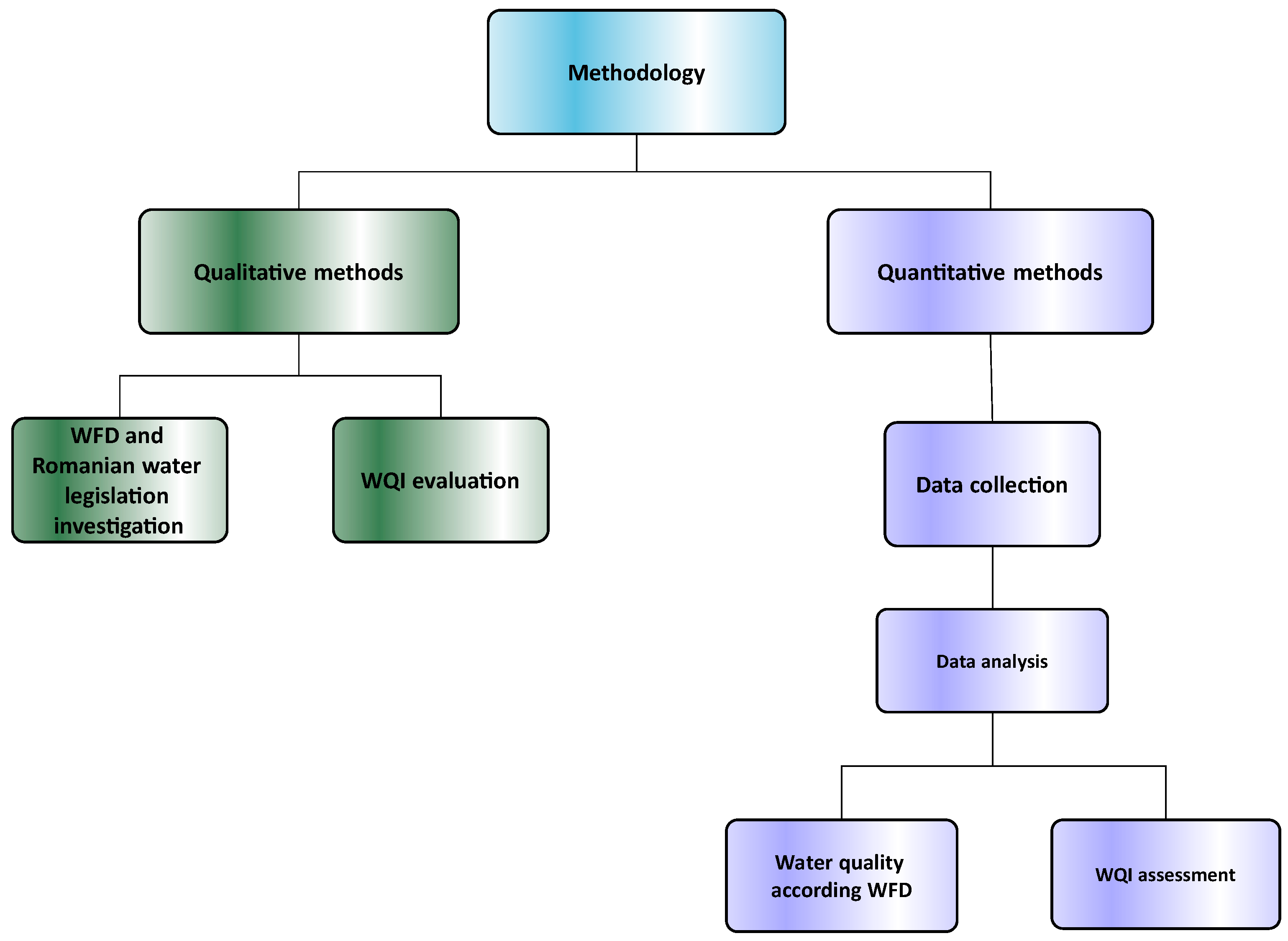
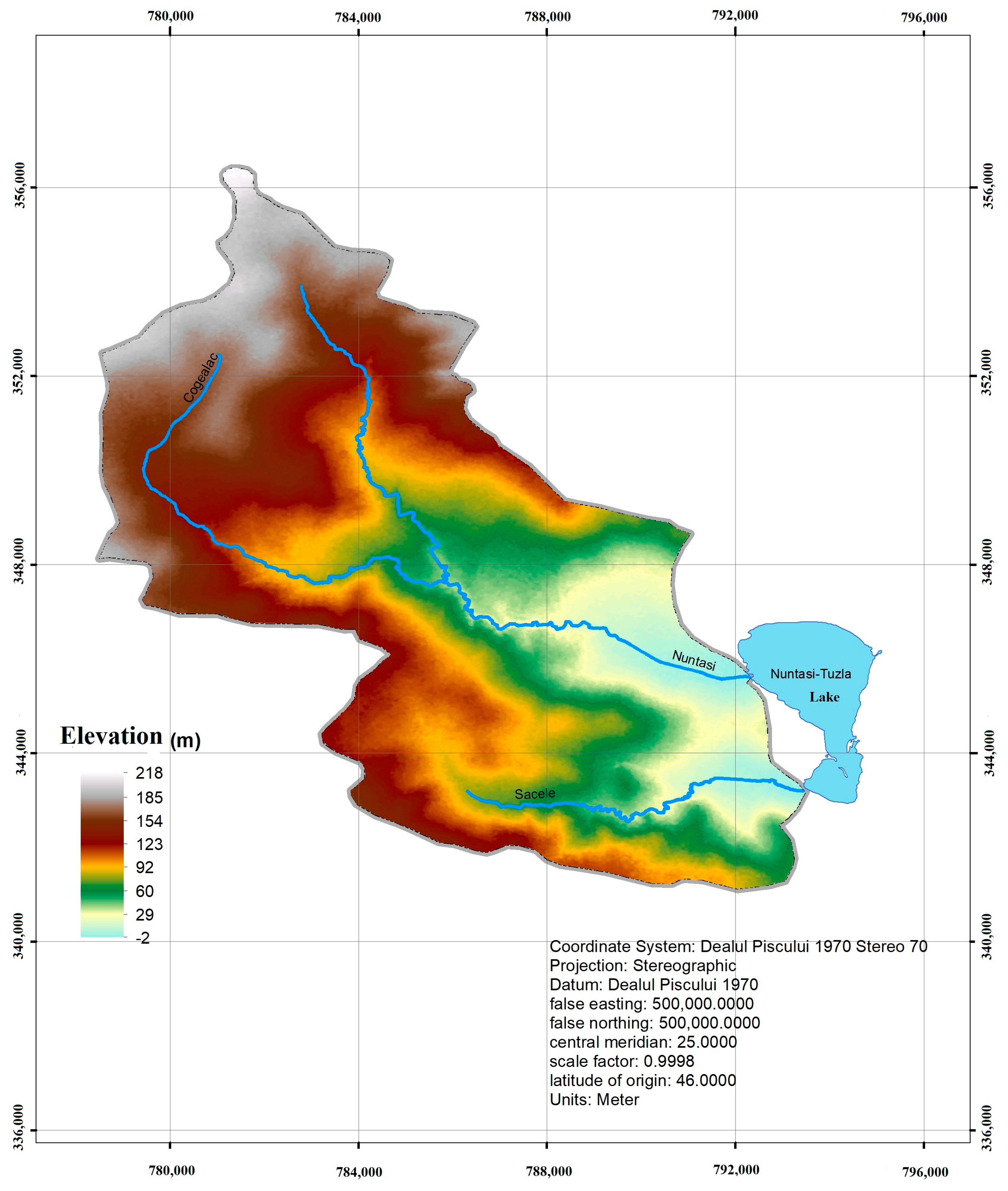
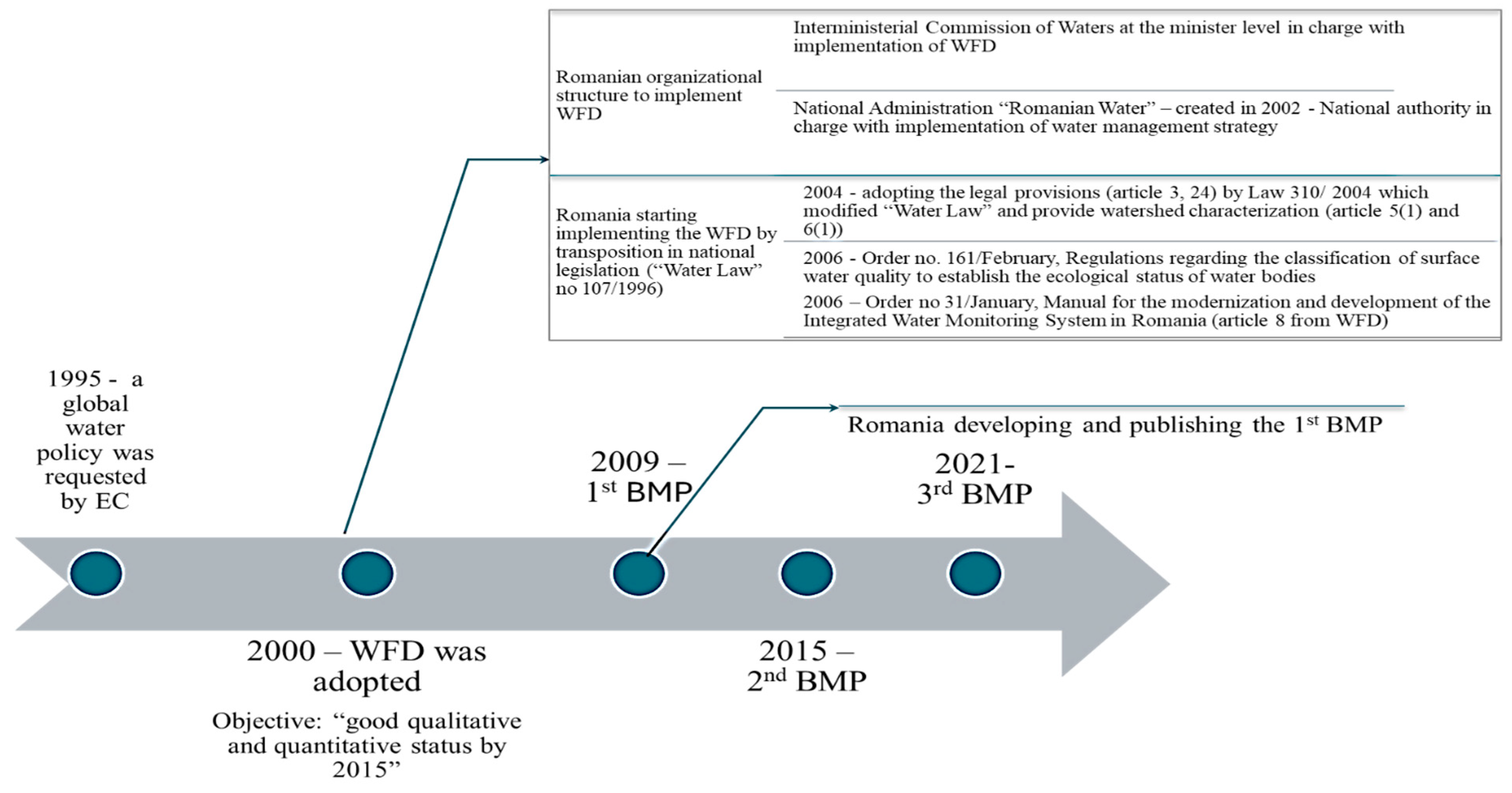
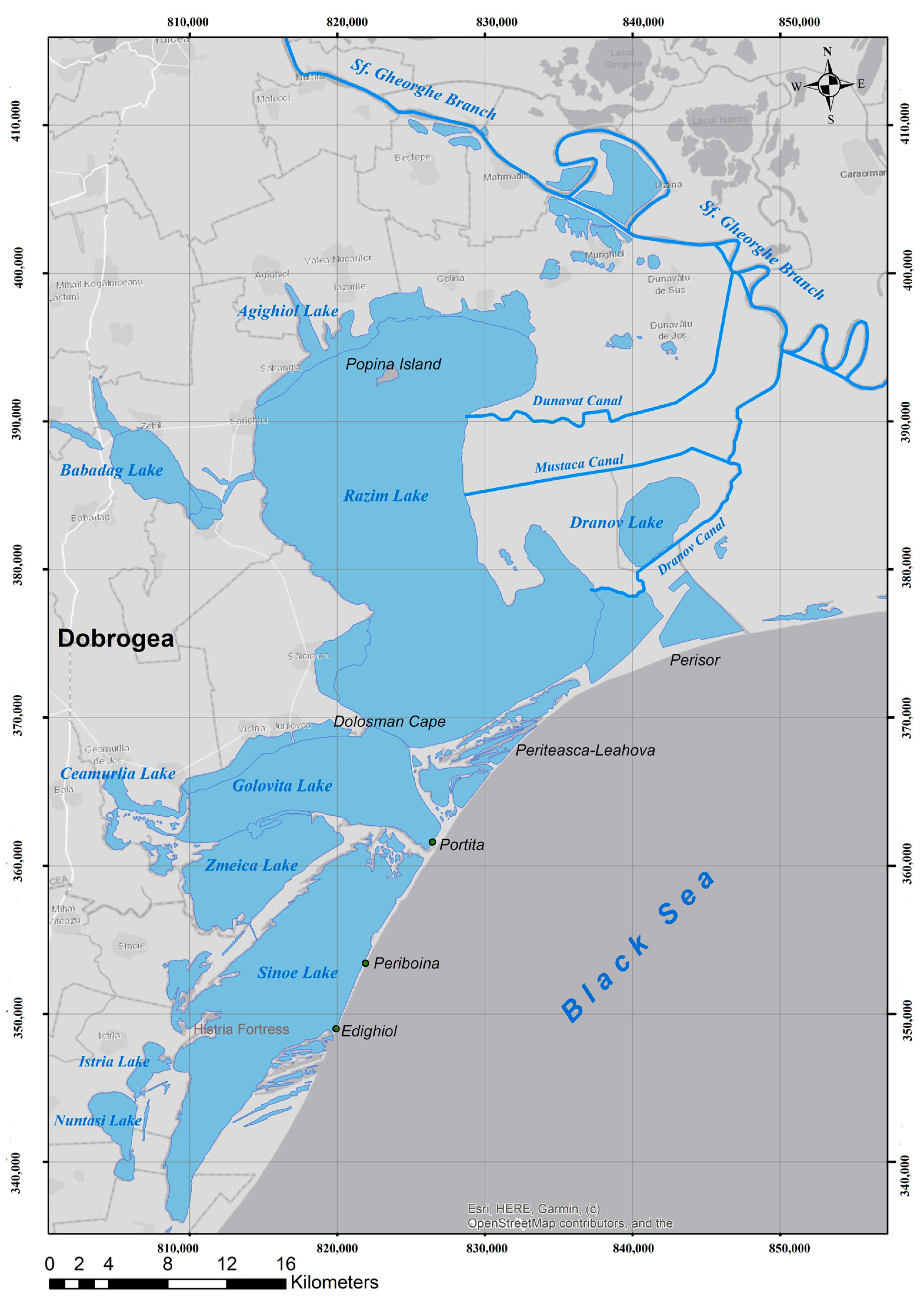
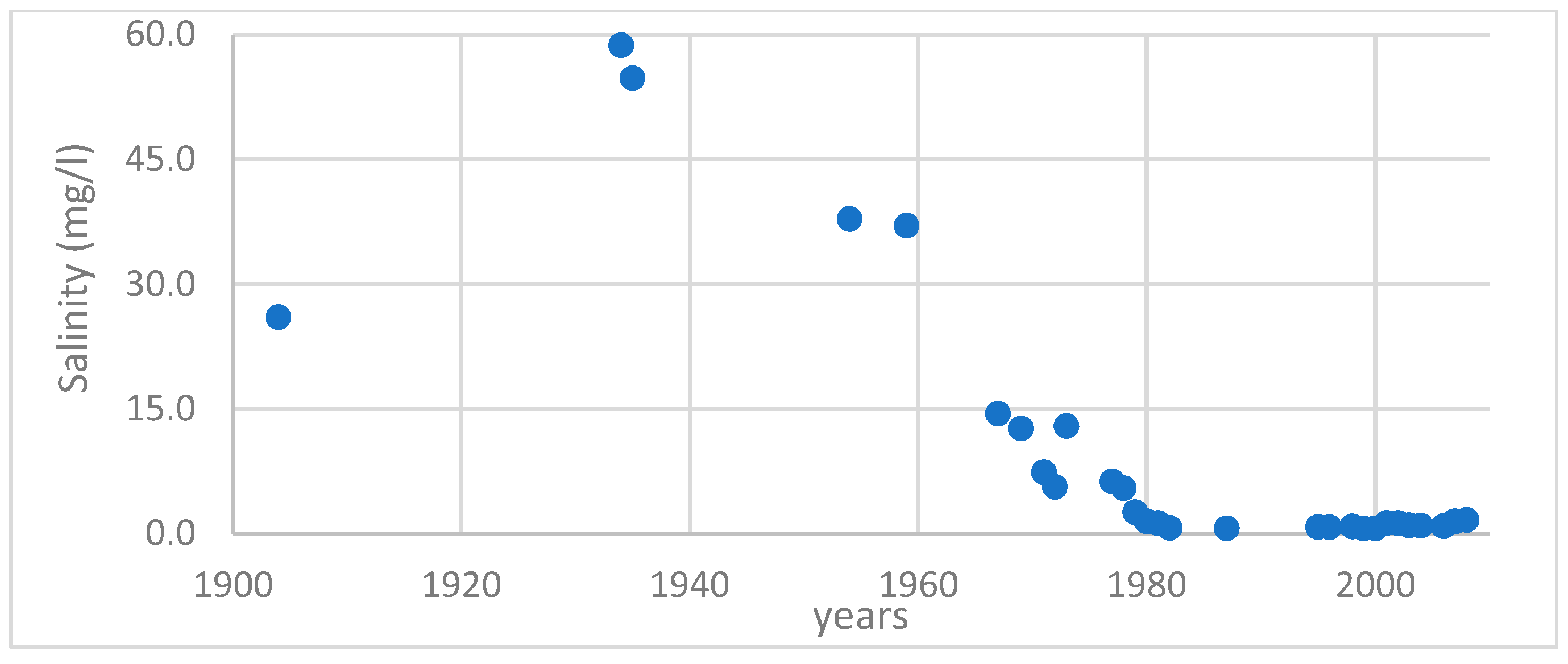
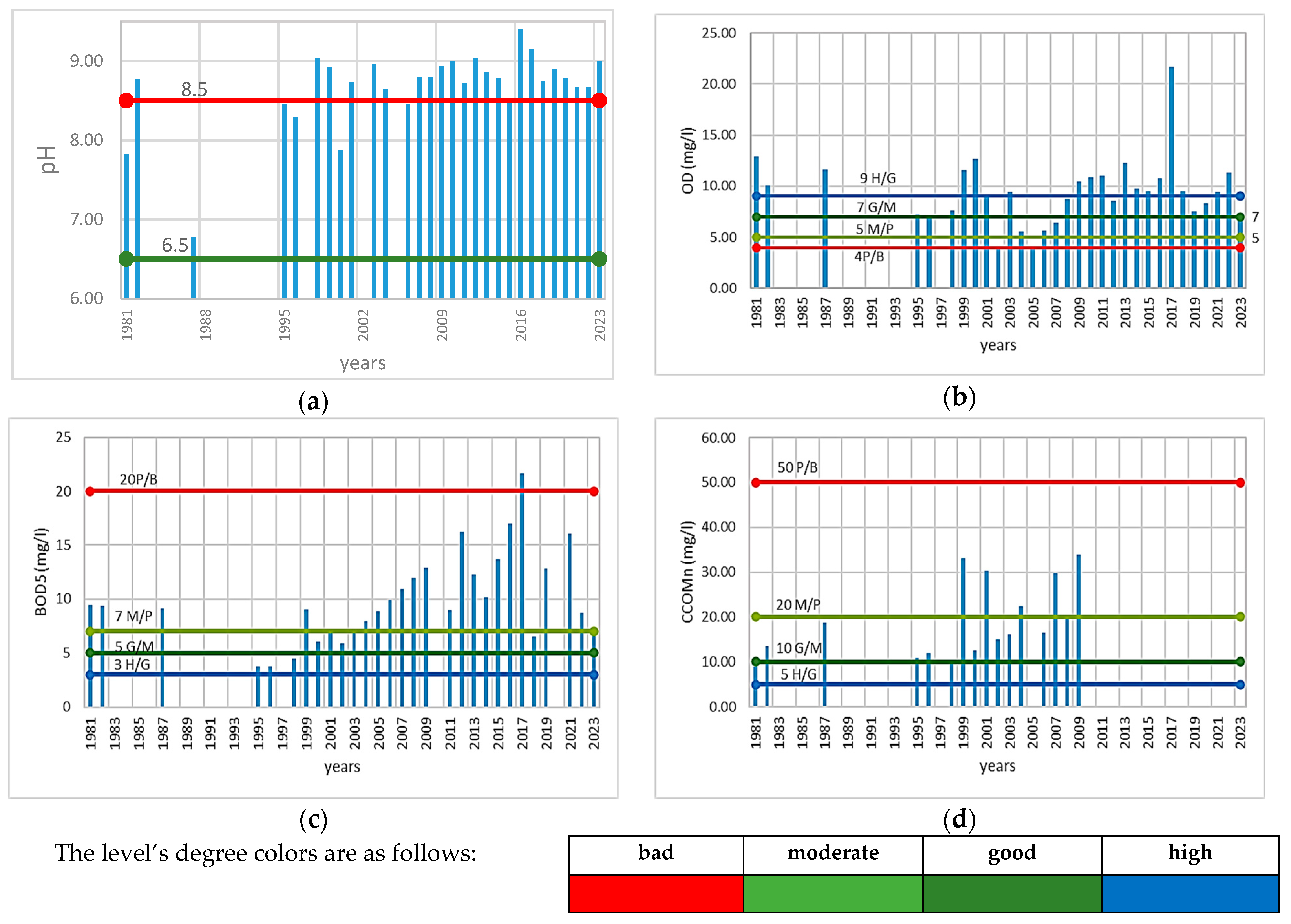

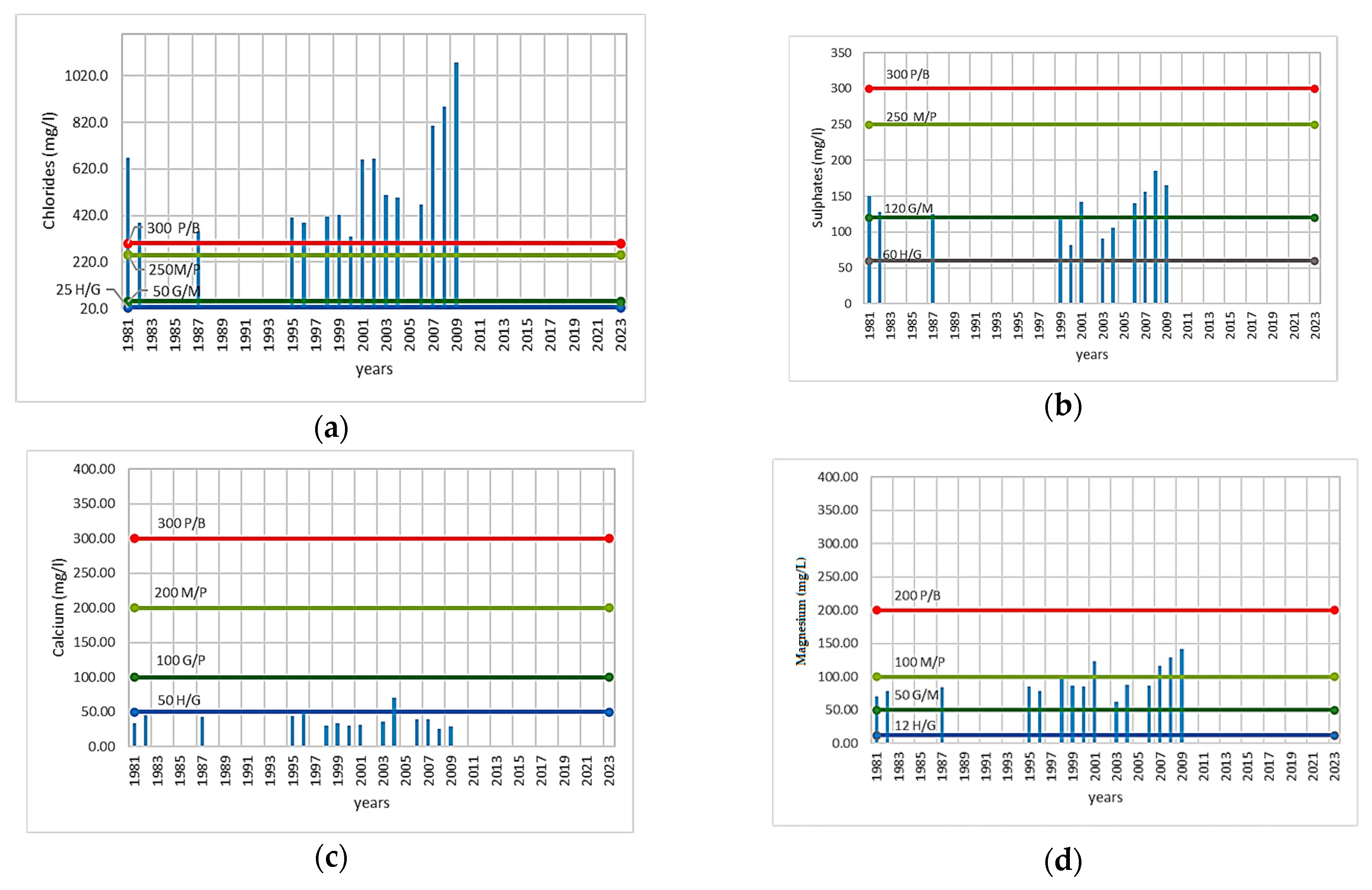
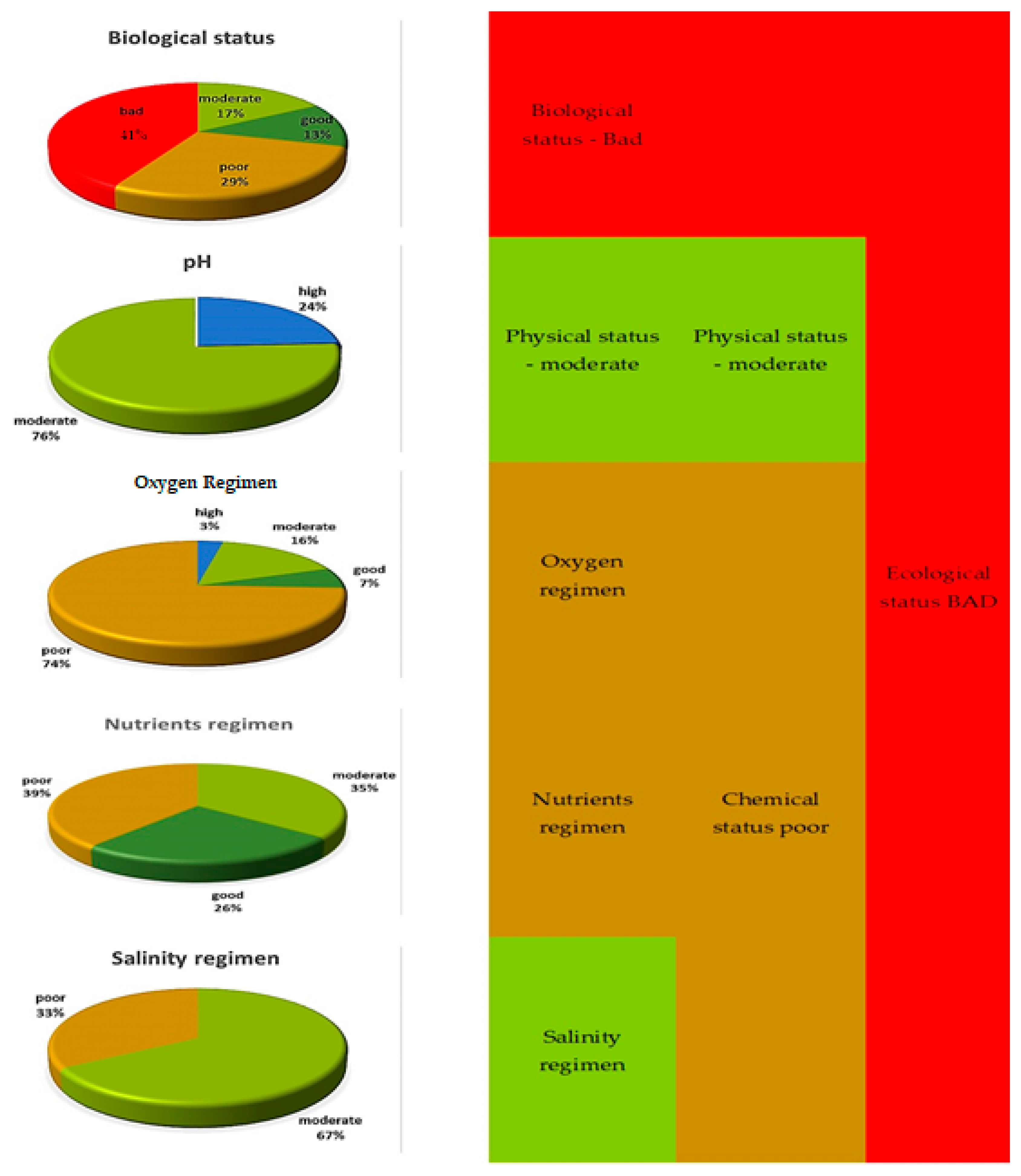
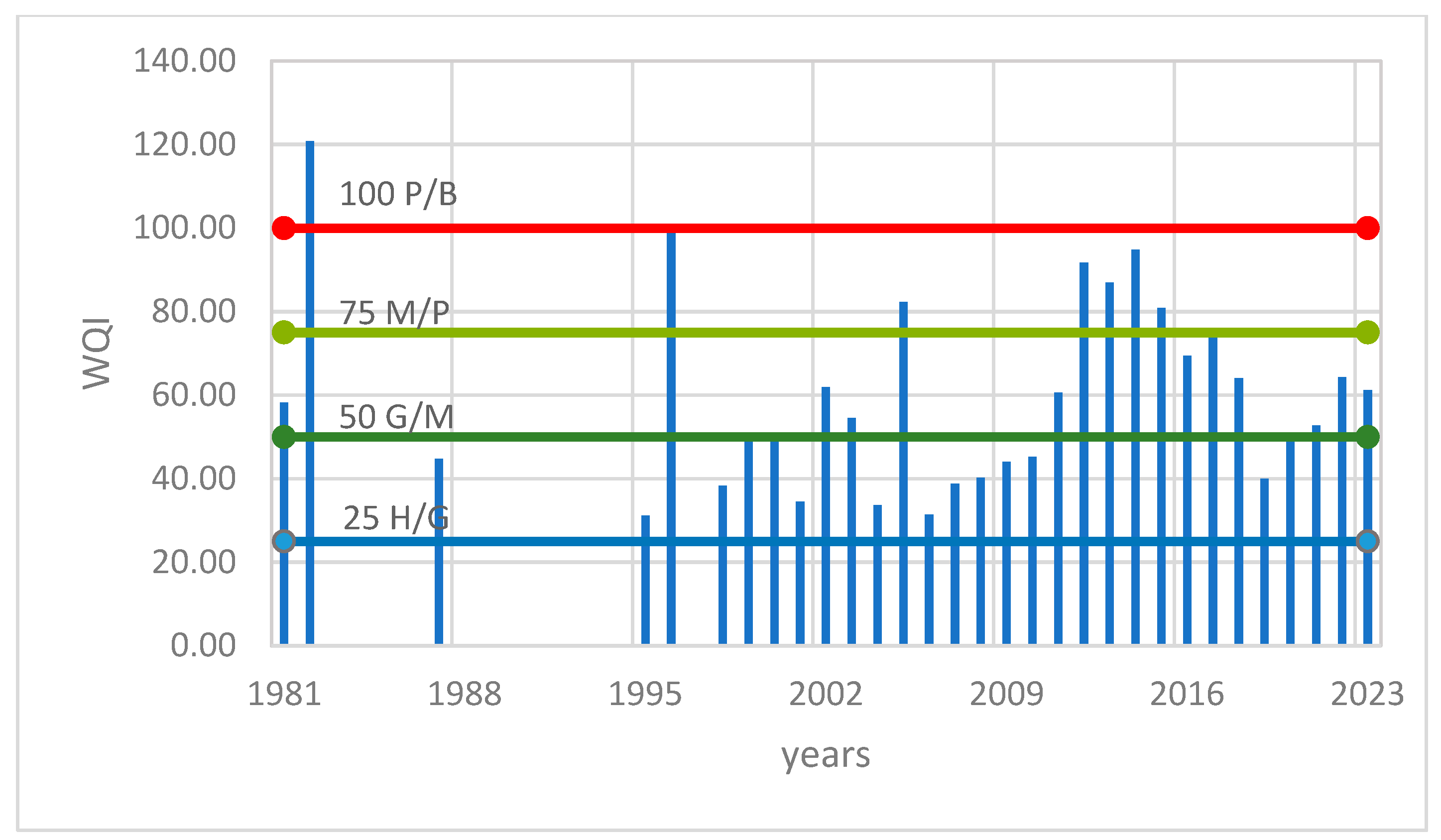
| pH | DO (mg/L) | BOD5 (mg/L) | CCOMn | Ammonium | Nitrate | N total | Phosphate |
|---|---|---|---|---|---|---|---|
| 7 | 7 | 5 | 10 | 0.8 | 3 | 7 | 0.2 |
| Total Phosphorus | Chloride | Sulfate | Ca | Mg | IM FPK | IM-B | IM-M |
| 0.4 | 50 | 120 | 100 | 50 | 0.6 | 0.6 | 0.6 |
| High/Excellent | Good | Moderate | Poor | Bad |
|---|---|---|---|---|
| ≤25 | 25–50 | 50–75 | 75–100 | ≥100 |
| Hydrometric Station | Subseries | Multi Annual Discharge (m3/s) | Observation |
|---|---|---|---|
| Nuntași | 1965–1980 | 0.467 | Before the maximum operation of the irrigation system |
| 1981–1989 | 0.638 | Maximum operation of irrigation system | |
| 1990–1996 | 0.409 | Partial work | |
| 1997–2006 | 0.239 | Closer | |
| 2007–2020 | 0.092 | ||
| Săcele | 1965–2003 | 0.104 | |
| 2004–2020 | 0.037 |
| Classification | Ammonium | Nitrate | Total Nitrogen * | Orthophosphate | Total Phosphorous | |||||
|---|---|---|---|---|---|---|---|---|---|---|
| Total Records | % | Total Records | % | Total Records | % | Total Records | % | Total Records | % | |
| high | 26 | 31 | 26 | 19 | 22 | no | 29 | 41 | 26 | 23 |
| good | 27 | 38 | 73 | 41 | 69 | |||||
| moderate | 27 | 23 | 23 | 3 | 8 | |||||
| poor | 15 | 19 | no | 10 | no | |||||
| bad | no | no | no | 3 | no | |||||
| Classification | Chlorides | Sulfate | Calcium | Magnesium | ||||
|---|---|---|---|---|---|---|---|---|
| Total Records | % | Total Records | % | Total Records | % | Total Records | % | |
| high | 16 | no | 12 | no | 15 | 93 | 15 | No |
| good | no | 33 | 7 | no | ||||
| moderate | no | 67 | no | 67% | ||||
| poor | no | no | no | 33% | ||||
| bad | 100 | no | no | no | ||||
Disclaimer/Publisher’s Note: The statements, opinions and data contained in all publications are solely those of the individual author(s) and contributor(s) and not of MDPI and/or the editor(s). MDPI and/or the editor(s) disclaim responsibility for any injury to people or property resulting from any ideas, methods, instructions or products referred to in the content. |
© 2025 by the authors. Licensee MDPI, Basel, Switzerland. This article is an open access article distributed under the terms and conditions of the Creative Commons Attribution (CC BY) license (https://creativecommons.org/licenses/by/4.0/).
Share and Cite
Dobrica, G.; Maftei, C.E.; Carazeanu Popovici, I.; Lupascu, N. Evolution of Nuntași-Tuzla Lake Chemistry in the Context of Human Intervention. Water 2025, 17, 1482. https://doi.org/10.3390/w17101482
Dobrica G, Maftei CE, Carazeanu Popovici I, Lupascu N. Evolution of Nuntași-Tuzla Lake Chemistry in the Context of Human Intervention. Water. 2025; 17(10):1482. https://doi.org/10.3390/w17101482
Chicago/Turabian StyleDobrica, Gabriel, Carmen Elena Maftei, Ionela Carazeanu Popovici, and Naliana Lupascu. 2025. "Evolution of Nuntași-Tuzla Lake Chemistry in the Context of Human Intervention" Water 17, no. 10: 1482. https://doi.org/10.3390/w17101482
APA StyleDobrica, G., Maftei, C. E., Carazeanu Popovici, I., & Lupascu, N. (2025). Evolution of Nuntași-Tuzla Lake Chemistry in the Context of Human Intervention. Water, 17(10), 1482. https://doi.org/10.3390/w17101482







